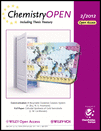
ChemistryOpen
Scope & Guideline
Where Chemistry Meets Accessibility
Introduction
Aims and Scopes
- Synthetic Chemistry and Catalysis:
The journal publishes significant contributions in synthetic methodologies and catalytic processes, exploring new reactions, catalysts, and their applications in organic synthesis. - Materials Chemistry:
Research on the design, synthesis, and characterization of novel materials, including nanomaterials, composites, and polymers, is a prominent focus, highlighting their properties and applications in various fields. - Analytical Chemistry:
The journal includes studies on novel analytical techniques and methods for the characterization of chemical compounds, environmental monitoring, and biomedical applications. - Biochemical and Medicinal Chemistry:
There is substantial coverage of research aimed at understanding biological processes and developing new therapeutic agents, including studies on drug design, synthesis, and biological evaluation. - Environmental Chemistry:
Research addressing environmental issues, including pollution analysis, remediation techniques, and sustainable practices, is a vital area of interest, reflecting the journal's commitment to addressing global challenges. - Computational Chemistry:
The journal supports articles that utilize computational methods to study chemical systems, including molecular modeling, simulations, and theoretical investigations to predict chemical behavior.
Trending and Emerging
- Green and Sustainable Chemistry:
There is a noticeable increase in research dedicated to green chemistry principles, including the development of eco-friendly synthesis methods, waste reduction, and sustainable materials. - Nanotechnology and Nanomaterials:
The application of nanotechnology in various fields, including drug delivery, catalysis, and materials science, is rapidly growing, with numerous studies focusing on the synthesis and characterization of nanomaterials. - Electrochemistry and Energy Storage:
Research in electrochemical methods for energy storage, including batteries and supercapacitors, is on the rise, highlighting the journal's engagement with renewable energy solutions. - Bioconjugation and Drug Delivery Systems:
The development of advanced drug delivery systems, including targeted therapies and biomaterials, is increasingly prominent, reflecting a shift towards more effective medicinal chemistry. - Machine Learning and Artificial Intelligence in Chemistry:
The integration of computational methods with machine learning and AI for predictive modeling and data analysis in chemistry is an emerging trend, showcasing the journal's commitment to innovative methodologies.
Declining or Waning
- Traditional Organic Synthesis:
Research focusing solely on traditional organic synthesis techniques without innovative or green chemistry approaches appears to be declining, as the field shifts towards more sustainable practices. - Inorganic Coordination Chemistry:
The exploration of classical coordination compounds and their properties seems to be waning, with fewer studies published that do not incorporate modern applications or interdisciplinary approaches. - Classical Spectroscopy Techniques:
While still relevant, the prevalence of studies employing conventional spectroscopy methods without the integration of advanced techniques or novel applications is decreasing. - Static Theoretical Chemistry:
Theoretical studies that do not incorporate dynamic simulations or practical applications are becoming less common, reflecting a shift towards more applied computational chemistry. - Conventional Polymer Chemistry:
Research focused on traditional polymer synthesis and characterization without addressing environmental impact or novel applications is receiving less attention in recent publications.
Similar Journals
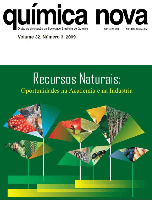
QUIMICA NOVA
Advancing Chemistry Through Open Access InnovationQUIMICA NOVA is a premier open access journal published by the SOC BRASILEIRA QUIMICA, dedicated to advancing the field of chemistry through the dissemination of high-quality research. Since its inception in 1997, the journal has provided a platform for innovative studies and scientific dialogue, making it a valuable resource for researchers, professionals, and students alike. With a focus on miscellaneous areas of chemistry, QUIMICA NOVA occupies a notable position with a 2023 Scopus ranking of #289 in General Chemistry, representing the 29th percentile among its peers. The journal's commitment to accessible science is underscored by its open access model, enabling broader readership and engagement. Hailing from Brazil, QUIMICA NOVA continues to contribute significantly to the global chemistry community, providing insights that drive progress and foster collaboration across disciplines.
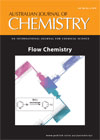
AUSTRALIAN JOURNAL OF CHEMISTRY
Elevating the standards of chemistry research worldwide.The Australian Journal of Chemistry, with an ISSN of 0004-9425 and an E-ISSN of 1445-0038, is a distinguished publication from CSIRO PUBLISHING, dedicated to advancing the field of chemistry since its inception in 1948. Based in Australia, this journal serves as a platform for original research articles, reviews, and innovative studies that encompass a wide spectrum of chemical disciplines, aiming to foster communication and collaboration among researchers globally. Despite its Q3 ranking in the Chemistry (Miscellaneous) category and standing at rank #236 in Scopus’ general chemistry classification, it remains an essential resource for professionals and students seeking to stay informed about emerging trends and discoveries in chemistry. The journal does not offer open access, emphasizing the premium quality of peer-reviewed content that adheres to rigorous academic standards. By bridging theory and practice, the Australian Journal of Chemistry continues to play a crucial role in shaping the future of chemical sciences.
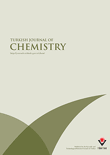
TURKISH JOURNAL OF CHEMISTRY
Empowering Scientific Progress in ChemistryTURKISH JOURNAL OF CHEMISTRY, published by the Tubitak Scientific & Technological Research Council Turkey, serves as a significant platform for the dissemination of research in the diverse field of chemistry. Since its inception in 1996, this peer-reviewed journal has made substantial contributions to the body of knowledge within the field, currently holding a respectable Q3 ranking in the category of Chemistry (miscellaneous) as of 2023. Researchers and professionals alike rely on this journal for its wide-ranging discussions, innovative methodologies, and noteworthy findings pertinent to both fundamental and applied chemistry. With an ISSN of 1300-0527 and a commitment to promoting scientific progress, the journal is accessible to a global audience and encourages the open sharing of insights that drive advancements in chemistry. The extended timeframe of convergence until 2024 highlights the journal's dedication to fostering ongoing research and collaboration within the scientific community. As a valuable resource for researchers, professionals, and students, the Turkish Journal of Chemistry aims to inspire new discoveries and facilitate knowledge transfer in a dynamic and evolving discipline.

Jordan Journal of Chemistry
Illuminating Chemistry: Open Access to Groundbreaking Research.The Jordan Journal of Chemistry is a prominent publication dedicated to advancing the field of chemistry in Jordan and beyond. Published by the Yarmouk University Deanship of Research & Graduate Studies, this journal serves as a platform for researchers, educators, and practitioners to disseminate their findings in a variety of chemistry sub-disciplines. Although currently classified in Q4 of miscellaneous chemistry and ranking within the 9th percentile according to Scopus, the journal plays a crucial role in fostering academic dialogue and collaboration in the region. With its ISSN 1814-9111 and E-ISSN 2079-7249, the Jordan Journal of Chemistry offers open access to researchers from diverse backgrounds, ensuring that critical research is both accessible and impactful. By bridging local studies with global scientific advancements, this journal is poised to contribute significantly to the growth and recognition of chemistry as a key scientific discipline in the region, with convergence efforts set from 2020 to 2024.

JOURNAL OF CHEMICAL RESEARCH
Exploring the Frontiers of Chemical Science.JOURNAL OF CHEMICAL RESEARCH, published by SAGE PUBLICATIONS LTD, serves as a pivotal platform for scholars and practitioners in the field of Chemistry. With its ISSN 1747-5198 and E-ISSN 2047-6507, this journal has established itself as a reliable source of innovative research since its inception in 2000. The journal's comprehensive scope encompasses various facets of chemical research, providing a broad spectrum of articles that foster scientific advancement and technological innovation. Ranked in the Q3 tier of miscellaneous chemistry journals in 2023, with a Scopus rank of #246 out of 408, it represents a solid outlet for emerging and established researchers alike. Although currently not an open-access journal, its rigorous peer-review process ensures that only high-quality studies are published, catering to the academic and professional community's demand for credible and impactful findings. Positioned in the vibrant research landscape of the United Kingdom, the JOURNAL OF CHEMICAL RESEARCH is dedicated to expanding the frontiers of chemical sciences and is an essential resource for anyone committed to advancing this dynamic field.

Bulletin of the University of Karaganda-Chemistry
Elevating Academic Discourse in the World of ChemistryBulletin of the University of Karaganda-Chemistry is an esteemed academic journal published by KARAGANDA STATE UNIVERSITY, focusing on the field of chemistry and related disciplines. With an ISSN of 2518-718X and an E-ISSN of 2663-4872, this journal aims to disseminate high-quality research articles, reviews, and scholarly discussions that contribute to the advancement of knowledge in chemistry. Although it has experienced a transition in its coverage from 2021 to 2022, the journal remains a significant platform for researchers and students alike, promoting open access to its valuable content. Despite its current Scopus rank of #379/407 in the general chemistry category, the Bulletin of the University of Karaganda-Chemistry serves as a vital resource for the academic community in Kazakhstan and beyond, fostering collaboration and innovation in various chemical research domains. Researchers, professionals, and students are encouraged to engage with the journal as it continues to evolve and contribute to significant scientific discussions.
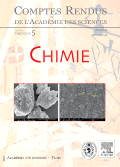
COMPTES RENDUS CHIMIE
Sharing Insights, Transforming the Future of Chemical Research.COMPTES RENDUS CHIMIE, published by the prestigious Académie des Sciences in France, stands as a significant journal in the fields of chemistry and chemical engineering. With an ISSN of 1631-0748 and an E-ISSN of 1878-1543, this open-access journal has been committed to disseminating high-quality research since its transition to open access in 2020. Featuring a diverse array of studies, the journal covers innovative research trends and applications, while maintaining a Q3 category ranking in both Chemical Engineering (miscellaneous) and Chemistry (miscellaneous) as of 2023. Its Scopus rankings, positioning at #251 out of 408 in general chemistry and #169 out of 273 in general chemical engineering, highlight its growing impact within the scientific community. Authored by a global cohort of scientists and researchers, COMPTES RENDUS CHIMIE is dedicated to the advancement of knowledge and sharing insights that are vital for ongoing research and development in the chemical sciences. Located in the heart of Paris at 23 Quai de Conti, 75006, France, the journal is an essential resource for those passionate about chemistry and engineering disciplines, fostering collaboration and innovation across the world.
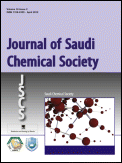
Journal of Saudi Chemical Society
Advancing Chemistry Knowledge, One Article at a Time.The Journal of Saudi Chemical Society, published by ELSEVIER, stands as a premier platform for advancing knowledge in the field of chemistry. Since its inception in 2009, this Open Access journal has garnered significant attention, securing a prestigious Q1 ranking in the Chemistry (miscellaneous) category for 2023, reflecting its position among the top journals in the discipline. With an impressive Scopus ranking of #66 out of 408 in General Chemistry, this journal boasts a commendable 83rd percentile, underscoring its impact and relevance in the global research community. The journal aims to disseminate high-quality research articles, reviews, and case studies, fostering innovation and collaboration among chemists and allied professionals. By enabling widespread access to cutting-edge research, the Journal of Saudi Chemical Society plays a crucial role in supporting the educational and professional development of students, researchers, and practitioners alike, making it an essential resource for anyone invested in the dynamic field of chemistry.

CHINESE JOURNAL OF CHEMISTRY
Connecting global minds in chemistry.The CHINESE JOURNAL OF CHEMISTRY, published by WILEY-V C H VERLAG GMBH, is a distinguished peer-reviewed journal that has been contributing to the field of chemistry since its inception in 1990. With an impressive Q1 ranking in the Chemistry (miscellaneous) category and a Scopus rank of 67 out of 408, this journal is recognized for its rigorous scholarly standards and significant impact within the academic community. Renowned for publishing high-quality research, reviews, and insightful commentaries, the journal serves as a vital resource for researchers, professionals, and students keen on advancing their understanding of general chemistry and its applications. Although it does not offer open access, the journal remains an essential outlet for innovative chemistry research, attracting contributions from a global network of specialists. With its broad scope covering various aspects of chemistry and a commitment to fostering scientific dialogue, the CHINESE JOURNAL OF CHEMISTRY is poised to continue its role as a central pillar in the ever-evolving landscape of chemical sciences.

CHEMICAL RESEARCH IN CHINESE UNIVERSITIES
Exploring the Frontiers of Chemical ScienceCHEMICAL RESEARCH IN CHINESE UNIVERSITIES is a prominent academic journal dedicated to the dissemination of high-quality research in the field of chemistry and related educational methodologies. Published by HIGHER EDUCATION PRESS, this journal has established itself as a vital resource for researchers and professionals looking to stay at the forefront of chemical sciences. With an impressive impact factor and ranked in the Q2 quartile for both Chemistry and Education categories, it highlights significant advancements while maintaining rigorous peer-review standards. The journal's ISSN is 1005-9040 and its E-ISSN is 2210-3171, ensuring broad accessibility to its global readership. Although it does not offer open access, its contributions are vital to understanding the dynamics of chemistry research and education within and beyond China. With converged publication years from 1999 through to 2024, CHEMICAL RESEARCH IN CHINESE UNIVERSITIES continues to be an essential platform for innovative studies and critical discussions in the expanding realm of chemistry.